Luang Prabang

Luang Prabang
First settled more than 1200 years ago at the confluence of the Nam Khan and Mekong Rivers in the heart of Northern Laos,Luang Prabang city has served as the capital of kingdoms both ancient and modern.Luang Prabang Province is situated in the center of northern Laos, bordering the provinces of Oudomxay, Phongsaly and Houaphanh to the north, Vientiane the capital and Xayabouly to the south and south west and Xieng Khouang to the east.Luang Prabang province has a population of just over 400,000 people, including 8 distinct ethnic groups. The Kmhmu–often this is spelled Khmu– are the largest ethnic group in the province and make up the majority (around 44%) of its population. The Hmong are the second most populous ethnic minority (16%). Low land Lao people comprise 39% of the population and live mostly in lowland valleys and Luang Prabang town.Luang Prabang is best known today for its protected, unique juxtaposition of temples, traditional architecture, and colonial buildings and for the natural beauty of its surrounding province. And even as the city warmly welcomes visitors from all over the world, it remains a vital political, educational, and trade hub for the diverse cultures of Northern Laos.
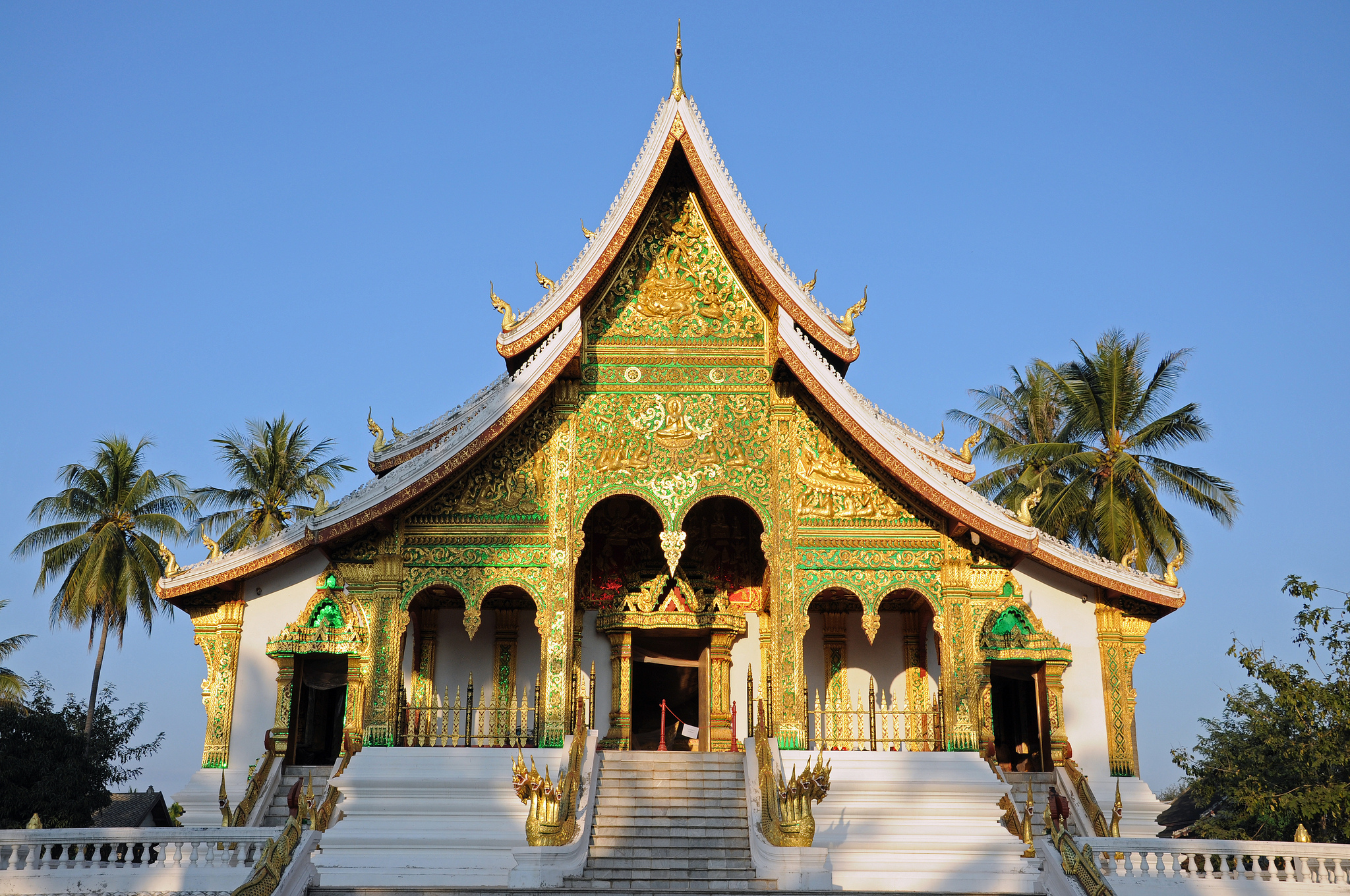
The Royal Palace in Luang Prabang also known as “Haw Kham” and translated to “Golden Palace” was once Laos’ Royal Palace. The former Royal Palace is located on the banks of the Mekong River and faces the Mount Phousi. The palace houses a lot of historical items with interesting stories behind. The Royal palace is worth a visit, and you will learn more about Lao history and culture. Visitors to the Royal Palace can photograph golden-adorned and marble architecture, particularly at the entrance to the palace, and view mural-covered walls that once surrounded royal officials. An art collection on the grounds features the Phra Bang, an 83-centimeter-tall Buddha cast in gold, silver and bronze. Visitors also can see treasured gifts given to diplomats through the years. One exhibit features a moon rock donated by the United States following a mission to space. Things to know when visiting the Royal Palace.
Visitors to the Royal Palace can photograph golden-adorned and marble architecture, particularly at the entrance to the palace, and view mural-covered walls that once surrounded royal officials. An art collection on the grounds features the Phra Bang, an 83-centimeter-tall Buddha cast in gold, silver and bronze. Visitors also can see treasured gifts given to diplomats through the years. One exhibit features a moon rock donated by the United States following a mission to space. Things to know when visiting the Royal Palace.
Dress appropriately. Visitors should wear long trousers, or skirts that cover the ankles, and shirts with sleeves.
Once inside the museum, guests are asked to remove their shoes (socks can stay on – thank goodness, right?) and to leave their backpacks in a storage area at the entrance.
No photographs are allowed inside the museum.
Entry to the museum grounds is free. But it costs you 30,000 kip ($3.5) to get to the palace building. There is a ticket box to the right of the entrance. Children under 10 free of charge. Opening hours: every day from 8:00 – 11:30 am and 1:00 – 3:00 pm.
Wat Xiengthong
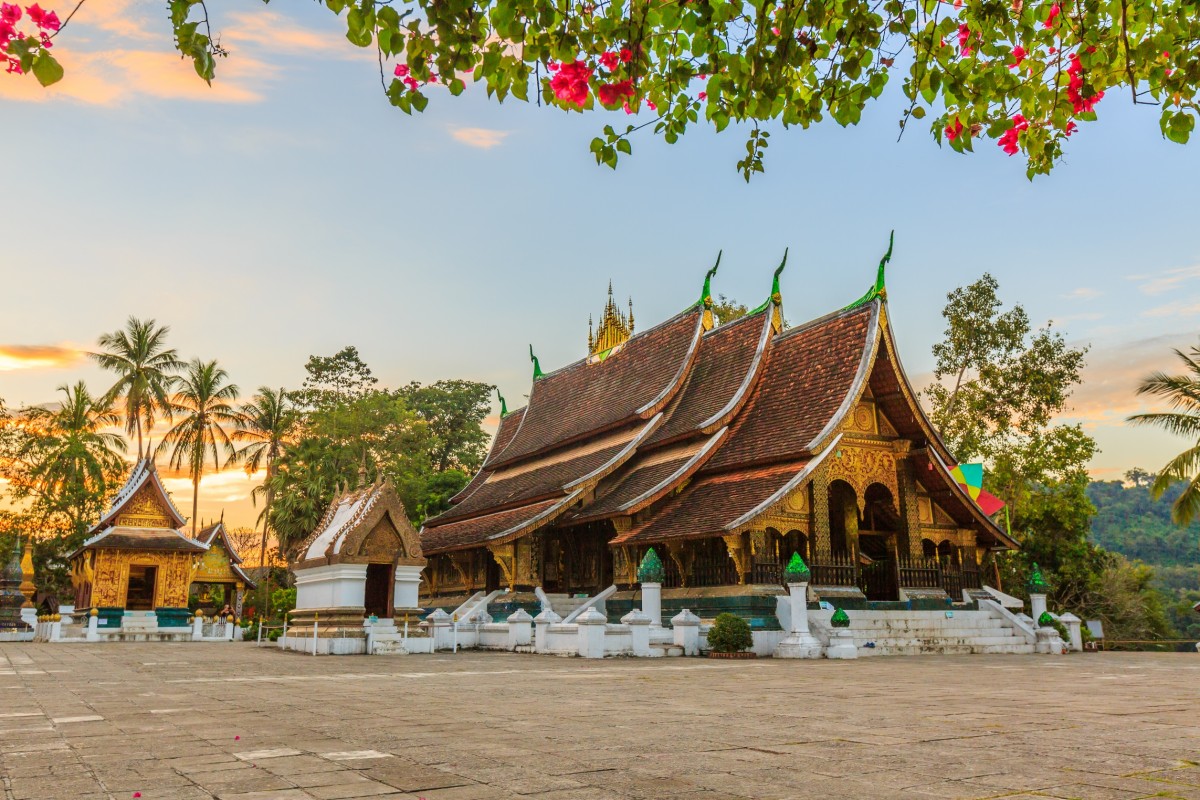 This temple is not only the most beautiful in Luang Prabang, but arguably one of the most spectacular temples in the entire country. Built by King Setthatirath around 1560 it is a classic example of Luang Prabang style and features a gracefully sloping roof and glass murals.
This temple is not only the most beautiful in Luang Prabang, but arguably one of the most spectacular temples in the entire country. Built by King Setthatirath around 1560 it is a classic example of Luang Prabang style and features a gracefully sloping roof and glass murals.
The best time to visit, especially for photography, is in the morning.Wat Xieng Thong is a Buddhist temple (wat) on the northern tip of the peninsula of Luang Phrabang, Laos. Wat Xieng Thong is one of the most important of Lao monasteries and remains a significant monument to the spirit of religion, royalty and traditional art. There are over 20 structures on the grounds including a sim, shrines, pavilions and residences, in addition to its gardens of flowers, ornamental shrubs, and trees.Wat Xieng Thong was built 1559-1560 by the Lao King Setthathirath near where the Mekong and Nam Khan rivers join. Until 1975 the wat was a royal temple under the patronage of the royal family and the Lao kings were crowned in the wat.
The wat is considered as representing typical Laos art and craft. The building of the wat have carved gilded wooden doors depicting scenes from Buddha’s life. In the sim the ceiling displays Dharmachakras — dharma wheels symbolising Buddhist law and the circle of reincarnation. The outer walls of the sim depict Lao legends and the rear gable is decorated with a glass mosaic depicting the tree of life. The outer walls of the Sanctuary of the Reclining Buddha, also known as Red Chapel, are decorated with mosaics.In 1880, the Tripitaka library was added and the drum tower in 1961. This temple, along with Wat Suwannaphumaham, was spared by any damage during the sacking of the city in 1887. This was because the Black Flag Haw leader, Đèo Văn Trị, had studied here as a monk in his early life and used it as his headquarters during the sacking of Luang Phrabang.On one side of the sim, there are small halls and stupas that contain Buddha images of the period. There is a reclining Buddha sanctuary, which contains an especially rare reclining Buddha that dates from the construction of the temple. In 1931, the image was taken to France and displayed at the Paris Exhibition. It was kept in Vientiane until 1964, where it returned to Luang Phrabang. In the near compound’s eastern gate stands the royal funerary carriage house, where it houses the funeral carriage, which stands 12 meters high and there are various urns for the members of the royal family.
A number of restorations have taken place in the 20th century, including a notable one in which the French participated. In 1928, when the French Governor General visited Luang Prabang, the King Sisavangvong successfully demanded that the French share in the cost of restoration. Major projects took place in the 1950s and 1960s, when the funerary carriage house was built, and especially in more recent times to repair the damage brought by years of damage from of wars and neglect.
Opening hours: daily 08:00am – 17:00pmDo’s and Don’ts– Cover yourself from shoulders to knees, take off hats and shoes.
– Respect the monks and novices. Women are not allowed to touch them.
– Do not show affection publicly.
– Refuse any antiques or you will be fined.
Wat Aham

The Wat Aham is a small temple consisting of a sim and two ancient stupas. It has a history of both Buddhism and spirit worship. The temple was built in 1818 on the site of a much older temple dating back to 1527.
Between the street and the temple are two very large and old banyan trees that harbour the Devata Luang, the guardian spirits of Luang Prabang town. Next to the Wat Aham is the Wat Wisunalat. A large elaborate gateway connects the two temples.
Opening hours: The temple opens daily from 8 am until 5 pm.
Wat Wisunalat
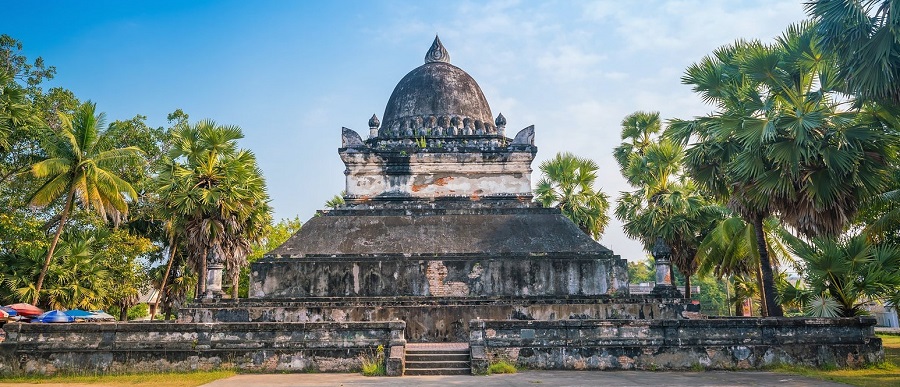
Wat Wisunalat (Vixoun, Visounnarath, Vixunhalat, Wisunarat) was originally built during the reign of King Wisunarat (or Vixoun, 1501-1520) in 1513 (some suggest 1512) and represents the earliest style, sometimes referred to as Luang Prabang Style I, of Lao temple architecture. This style also includes the sims of Wat That Luang and Wat Mai. Wat Wisunalat is Luang Prabang’s oldest operating temple. As with the sims of most Lao wats, there are multiple roof structures. In the Style I form the first and second roofs extend around the entire perimeter of the structure. Except for the sim at Wat Mai, which was embellished by two additional gable roofs and two roofed side galleries, the style evokes simplicity, since the sim employs neither the high peaks of the gable nor the dramatic low sweeping roofs of many of the other sims of Luang Prabang. Located and adjoining Wat Aham to the southeast, it was probably built on the rice fields of the guardian spirits of the city (devata luang), Pu No and Na No (Phou Nheu and Nha Nheu). The sacred Prabang image was housed in the sim from 1513 until it was taken to Vientiane in 1707.
The original highly ornate wooden sim was a spectacular example of Lao craftsmanship at its finest and was one of the most imposing religious structures of old Luang Prabang. It had a double roof with the upper roof raised high above the lower roof. It was over 118 ft. (36m) long and 59 ft. (18m) wide; perhaps 4,000 trees were used in its construction. Each of the twelve pillars supporting the roof was almost 100 ft. (30 meters) high. There were twenty-one windows with turned wooden balustrades. Louis Delaporte’s engraving of its appearance in the 1860s is included in the series of photographs that follow on this site and shows the unique character of the sim. Most of the partitions of the original building were carved wood, and the exterior, as portrayed in the engraving, made it one of the most beautiful in Luang Prabang. It also housed a major collection of rich religious objects and other objects d’art. Much of the sim and the city were destroyed during the invasion of the Chinese Haw Black Flags marauders in 1887.
The sim was rebuilt between 1896 and 1898 and during the reign of King Sakkarin Kamsuk (r. 1894-1903). The style was somewhat to the old sim with its numerous massive wooden beams, window placement and style of the roof, albeit the major part of the structure was brick and plaster in place of the wood. The window balustrades attempt to capture the flavor of the older turned wooden balustrades of the original sim. The sim today continues its existence as a valuable of museum religious art with numerous centuries old Buddha statues in bronze and gilded and unadorned wood, ordination precinct stones and other religious objects.
Another important and prominent feature of the wat is its unique That Pathoum, or Stupa of the Great Lotus, in the front and northeastern side of the sim. It is known more popularly as That Makmo, the “Watermelon Stupa” because of its rounded dome. The dome stylistically reflects a Sinhalese influence and is the only stupa of such a shape in Laos, and perhaps even in Cambodia or Vietnam. Originally erected between 1514 and 1515, it was destroyed during the Haw Black Flag incursion in 1887. Inside were numerous ancient Buddha images. Many were destroyed; a number are in the National Palace Museum, and some are in the sim itself. Its reconstruction was not seriously undertaken until the late 1920s, over thirty years after the reconstruction of the sim, and was completed in 1932. The stupa sets on a number of different square tiers and has a Lao-Buddhist style Usnisa crown at its top.
Opening hours: The temple opens daily between 8 am and 5 pm.
Wat Mahathat
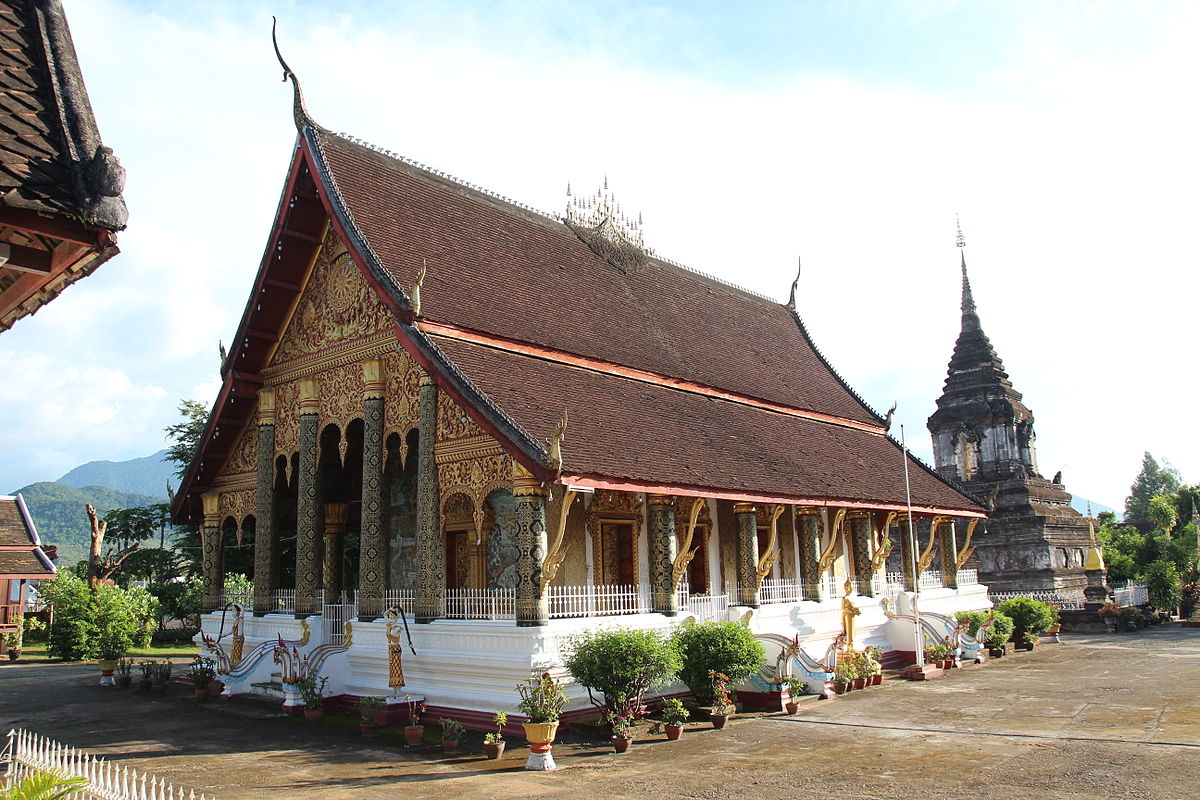
The temple was established in 1543 by King Setthathirath, although most parts of the temple has been rebuilt since due to damage caused by flooding.
Wat Mahathat, also known simply as Wat That, means ‘Temple of the Great Stupa’. The reason for the name is that a large Northern Thai style stupa was constructed during the mid 16th Century in the temple grounds. King Setthathirath was, by consequence of marriage, also the King of the Lanna Kingdom in what is now Northern Thailand and for this reason he choose to construct a Thai style stupa in Luang Prabang. This stupa is the only part of the original 16th Century temple which remains intact today.
As well as the main stupa, a number of smaller stupa have been added to the site subsequently. Three of these of the stupas were constructed to house the ashes of the last princes of the Laos royal family (Prince Phetsarath, Prince Souvanna Phouma and of Prince Souphanouvong) who were instrumental in the independence movement opposing French colonial rule in Laos and worked closely with the newly formed Lao Prathet Communist Government of Laos, despite the abolition of the Laotian monarchy in 1975.
The most beautiful part of Wat Mahathat is the shrine hall, or viharn, which has been constructed in front of the stupa. The shrine hall was rebuilt between 1907 and 1910 following a powerful storm which devastated much of Luang Prabang in 1900. The shrine hall is a work of art, literally, with murals of the Phra lak phra lam (the Laotian version of the Ramayana) and epic tales of King Thao Sithoanh and the Nang Manola, which are divine half-bird halt-woman creatures also known as Kinnaree in Hindu mythology.
These murals are only one part of the massive artistic endeavour undertaken at this temple over a three period. The front gable end of the shrine hall is covered in elaborated designs in gold leaf and an equally intricate relief is featured on the main entrance doors to the temple. The two statues in front of the temple of Phra Mae Thorani, the Earth Goddess, who according to Buddhist tradition wrings out her hair to create a deluge of water that drowns the armies of the Demon God Mara who attempts to attack the Lord Buddha during the marathon meditation session which culminates his attaining a state of enlightenment.
Opening hours: The temple opens from 8 am until 5 pm.
Phousi Mountain & That Chomsi

A terrace at the foot of the stupa offers an 360° panoramic view of the town. A MUST DO, especially in the evening, during the sunset, when the golden Stupa reflects the last light rays on one of its face.During the Pimai Festival, woman carry flower offerings up the stairs and leave as offerings at the foot of the stupa.One of the most interesting aspects of Mount Phousi lies in the legend which surrounds it. Tradition has it that at the site of the sacred hill there used to be a deep pit that led to the centre of the earth. Helped by villagers, a monk went down into the pit and found an immense treasure. The villagers seized the treasure and buried the monk alive by sealing the entrance to the pit. However, armed with magical charms, the monk succeeded in extricating himself after defeating the seven guardians of the treasure. News of this murder attempt reached the ears of the king of Luang Prabang, who punished the villagers by condemning them to take turns in beating drums, gongs and cymbals every three hours to stop the dragons from disturbing mankind. This practice is still carried out today at nearby Wat Thum Thao.
Pak Ou caves It is said that Pak Ou Caves has existed for a long time, even before the arrival of Buddhism in Laos. Therefore, to show respect for this caves, whenever traveling here, Lao will place Buddha statues in the cave.Pak Ou Caves is located on the Mekong River, in the north of Luang Prabang. “Pak Ou” is meaning the caves at the estuary of Ou River. The cave system including 2 caves: Tam Ting and Tam Pum. Tam Ting caves, which means the cave of a thousand Buddha statues. According to the name, there are thousands of Buddha statues in all sizes from small to as high as the height of a person. The latest research shows that there are about 4,000 statues in two caves, 1,500 in the upper cave called Tam Pum cave and 2,500 statues in the other one as known as the main cave is called Tam Ting cave. Most of these statues are made from wood, painted with red or black lacquer, and finally covered with gold leaves. There are also some made from the horns of animal, bronze and ceramic.It is said that the ancient kings often visited the Pak Ou Caves on Pimay (Water Festival in Laos) and spent the night in this area to control the Buddha’s ceremony in this cave. During this time, a lot of people sailed boats from Luang Prabang to the Pak Ou Caves, along with the king to perform the ritual bathing Buddha.Today, for the convenience of tourists, it is built a stone stair system over 200 steps connecting Tam Ting cave to Tam Pum cave. Like Tam Ting Cave, Tam Pum Cave also has many big and small Buddha statues of all kinds that people have worshiped for hundreds of years. However, due to the structure of the cave, Tam Pum cave is much longer than Tam Ting cave. Tam Pum cave become much colder than the other because of this structure. Due to the light and a sacred Buddhist space, Tam Pum cave makes anyone feel mysterious when entering the cave.Not only creating a Buddhist area, Pak Ou Caves also creates an image of women with the looms. In the past, when Pak Ou Caves was not widely known, the locals weaving fabrics were mainly for their family and village. Since Pak Ou Caves has become one of the attractive tourist spots in Luang Prabang, this traditional product has become a souvenir for tourists.
It is said that Pak Ou Caves has existed for a long time, even before the arrival of Buddhism in Laos. Therefore, to show respect for this caves, whenever traveling here, Lao will place Buddha statues in the cave.Pak Ou Caves is located on the Mekong River, in the north of Luang Prabang. “Pak Ou” is meaning the caves at the estuary of Ou River. The cave system including 2 caves: Tam Ting and Tam Pum. Tam Ting caves, which means the cave of a thousand Buddha statues. According to the name, there are thousands of Buddha statues in all sizes from small to as high as the height of a person. The latest research shows that there are about 4,000 statues in two caves, 1,500 in the upper cave called Tam Pum cave and 2,500 statues in the other one as known as the main cave is called Tam Ting cave. Most of these statues are made from wood, painted with red or black lacquer, and finally covered with gold leaves. There are also some made from the horns of animal, bronze and ceramic.It is said that the ancient kings often visited the Pak Ou Caves on Pimay (Water Festival in Laos) and spent the night in this area to control the Buddha’s ceremony in this cave. During this time, a lot of people sailed boats from Luang Prabang to the Pak Ou Caves, along with the king to perform the ritual bathing Buddha.Today, for the convenience of tourists, it is built a stone stair system over 200 steps connecting Tam Ting cave to Tam Pum cave. Like Tam Ting Cave, Tam Pum Cave also has many big and small Buddha statues of all kinds that people have worshiped for hundreds of years. However, due to the structure of the cave, Tam Pum cave is much longer than Tam Ting cave. Tam Pum cave become much colder than the other because of this structure. Due to the light and a sacred Buddhist space, Tam Pum cave makes anyone feel mysterious when entering the cave.Not only creating a Buddhist area, Pak Ou Caves also creates an image of women with the looms. In the past, when Pak Ou Caves was not widely known, the locals weaving fabrics were mainly for their family and village. Since Pak Ou Caves has become one of the attractive tourist spots in Luang Prabang, this traditional product has become a souvenir for tourists.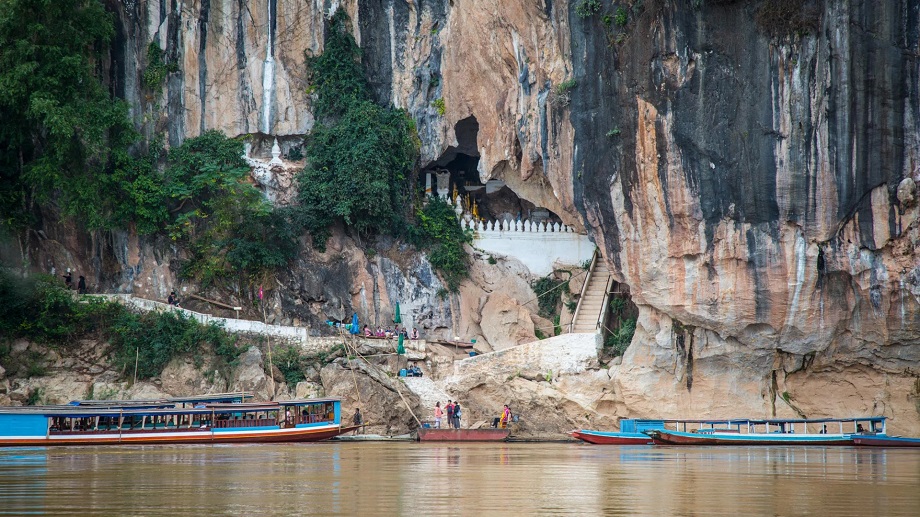 Located on a small mountain and facing the river, the only way to reach Pak Ou Caves is to hire the boat from the local people. Traveling to Pak Ou Caves is totally an interesting journey to explore the Land of Million Elephants.
Located on a small mountain and facing the river, the only way to reach Pak Ou Caves is to hire the boat from the local people. Traveling to Pak Ou Caves is totally an interesting journey to explore the Land of Million Elephants.
Kuang Si Falls The Kuang Si Falls is a three-leveled cascading waterfall located about 29 kilometers to the south of Luang Prabang city. These mesmerizing waterfalls also known by the name of Tat Kuang Si Waterfalls. Interesting Kuang Si Falls Facts
The Kuang Si Falls is a three-leveled cascading waterfall located about 29 kilometers to the south of Luang Prabang city. These mesmerizing waterfalls also known by the name of Tat Kuang Si Waterfalls. Interesting Kuang Si Falls Facts
- Location: 29km south of Luang Prabang, Laos
- Height: 50m drop
- Opening Hours: Every day from 8:00 until 17.30
- Kuang Si waterfall entrance fee: 20,000 kips
- Hiking time: 15-20 minutes
Best Time To Visit Kuang Si Falls The best time to visit the beautiful Kuang Si falls is a few months after the rain has ceased. The cascading pools begin to settle after the monsoon and the turquoise color returns around November. So, plan a visit to Kuang Si waterfall anytime from December through to April and May. Remember, that the waterfall does get crowded during weekends. So, if you want to avoid the crowds, you are better off planning an early visit on a weekday. Have your hotel pack you a picnic hamper and don’t forget to carry water, sunglasses, and some sunscreen.Places To Visit Near Kuang Si FallsTake a look at the places to visit near Kuang Si Falls while holidaying there to have the experience of a lifetime.
Tat Kuang Si Bear Rescue Centre Before you head out to the cascading pools of the beautiful waterfall, stroll through the Tat Kuang Si Bear Rescue Center. While this rescue center at first glance may seem more like a rudimentary zoo with barely much to see; it is sanctuary that is home to over 20 black bears rescued from dire circumstances. Some of these Asiatic bears have spent their lives at inhumane tiny cages while others have spent their time in Bear Bile farms to have their bile harvested. They have been rescued and given shelter at large enclosures with pools, hammocks, and play areas in their new home at the bear center. This rescue center doesn’t receive, any percentage of the entry fee paid towards Kuang Si. So, buy a t-shirt and mementos sold at the falls, if you wish to support the cause.
Before you head out to the cascading pools of the beautiful waterfall, stroll through the Tat Kuang Si Bear Rescue Center. While this rescue center at first glance may seem more like a rudimentary zoo with barely much to see; it is sanctuary that is home to over 20 black bears rescued from dire circumstances. Some of these Asiatic bears have spent their lives at inhumane tiny cages while others have spent their time in Bear Bile farms to have their bile harvested. They have been rescued and given shelter at large enclosures with pools, hammocks, and play areas in their new home at the bear center. This rescue center doesn’t receive, any percentage of the entry fee paid towards Kuang Si. So, buy a t-shirt and mementos sold at the falls, if you wish to support the cause.
Kuang Si Falls Butterfly Park

Laos Buffalo Dairy
Things To Do At Kuang Si Falls
Swim In The Turquoise Pools

The best part about these stunning falls is that apart from being mind-blowingly gorgeous, you can also take a quick dip in the tiered pool of blue waters. There are a number of pools that you can swim in at the main area. That is not all! There are rope swings and tree, from which you can dive into the pools. Now, if that isn’t fun, what is? However, take note of and pay heed to any signs that say no swimming in certain areas.
Hike To The Top of The Falls
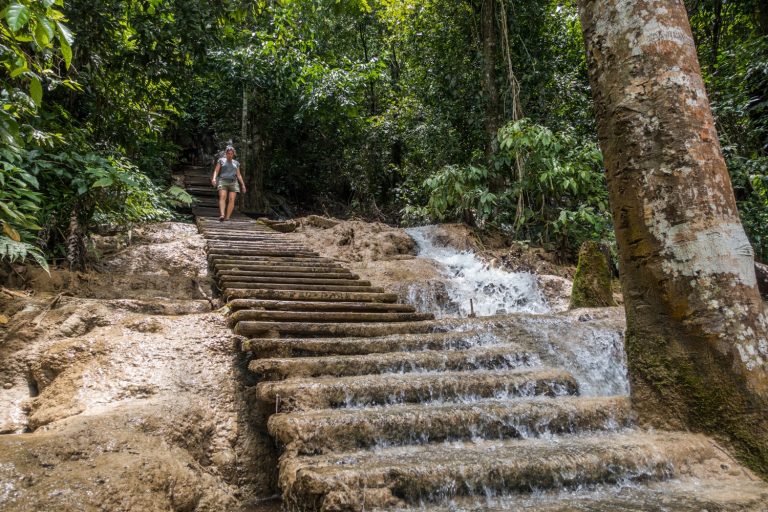
Most visitors congregate around the picnic area and lower pools. You could venture further to the small wooden footbridge that offers unobstructed views of the main fall. The hike will take no more than 15 minutes and isn’t very strenuous. At some parts you may find the terrain a tad bit tricky. The steps do not have railings and you will find water flowing over the path in some parts. This tricky hike is totally worth it, when you find yourself looking right over the breathtaking countryside below. Once you are ready to leave, take the path to the right. The way down is smooth, steep and step free and easy for most hikers to tackle.
Ban Xangkhong
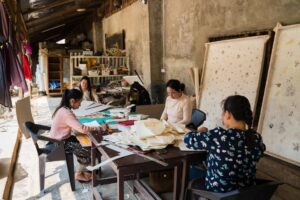
This is a handicraft village where Sa paper and silks are made. Besides experience the making process, visitors also have chance to interact with local people.
Sa paper

Through many generations, this small village has still remained the traditional Sa paper making process. Sa paper is made from mulberry trees. You can see many women work vats of water patting down paper (made primarily from tree bark) and setting the finished pieces out to dry. Those Sa papers are the main materials for making lanterns or cards. You also can try your skill by participate in making process.
Another handicraft here is weaving with traditional methods and natural materials. There are many women of various ages bent over their looms, crafting colorful silks into the scarves. There is also a small silkworm farm nearby to provide natural materials for weaving process.
Do not forget to buy some local gifts here because if you buy them in Luang prabang markets, the prices will be higher. However, you still need to bargain to get the reasonable prices.
